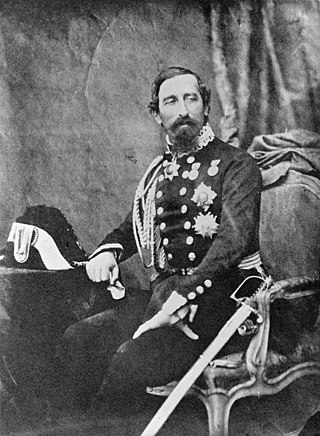Alfonso Ferrero La Marmora
Italian general and politician From Wikipedia, the free encyclopedia
Alfonso Ferrero La Marmora (Italian pronunciation: [alˈfɔnso la ˈmarmora]; 18 November 1804 – 5 January 1878) was an Italian general and statesman. His older brothers include soldier and naturalist Alberto della Marmora and Alessandro Ferrero La Marmora, founder of the branch of the Italian army now called the Bersaglieri.
Alfonso La Màrmora | |
|---|---|
 | |
| Prime Minister of Italy | |
| In office 28 September 1864 – 20 June 1866 | |
| Monarch | Victor Emmanuel II |
| Preceded by | Marco Minghetti |
| Succeeded by | Bettino Ricasoli |
| Prime Minister of Sardinia | |
| In office 19 July 1859 – 21 January 1860 | |
| Monarch | Victor Emmanuel II |
| Preceded by | Count of Cavour |
| Succeeded by | Count of Cavour |
| Personal details | |
| Born | 18 November 1804 Turin, French Empire |
| Died | 5 January 1878 (aged 73) Florence, Kingdom of Italy |
| Political party | Independent |
| Military service | |
| Allegiance | Kingdom of Sardinia Kingdom of Italy |
| Branch/service | Royal Italian Army |
| Years of service | 1823–1866 |
| Battles/wars | First Italian War of Independence Crimean War Second Italian War of Independence Brigantaggio Third Italian War of Independence |
Biography
Summarize
Perspective


Born in Turin, he entered the Sardinian army in 1823, and was a captain in March 1848, when he gained distinction and the rank of major at the siege of Peschiera. On 5 August 1848 he liberated Charles Albert of Sardinia from a revolutionary mob in Milan, and in October was promoted general and appointed Minister of War. After suppressing the revolt of Genoa in 1849, he again assumed in November 1849 the portfolio of war, which, save during the period of his command of the Crimean expedition (where he commanded at the siege of Sevastopol and the battle of the Chernaya), he retained until 1859.[1]
He took part in the war of 1859 against Austria; and in July of that year succeeded Cavour in the premiership. In 1860 he was sent to Berlin and Saint Petersburg to arrange for the recognition of the kingdom of Italy and subsequently he held the offices of governor of Milan and royal lieutenant at Naples, until, in September 1864, he succeeded Marco Minghetti as premier. In this capacity, he modified the scope of the September Convention by a note in which he claimed for Italy full freedom of action in respect of national aspirations to the possession of Rome, a document of which Visconti-Venosta afterwards took advantage when justifying the Italian occupation of Rome in 1870.[1]
In April 1866 La Marmora concluded a military alliance with Prussia against Austria-Hungary, and, on the outbreak of the Third Italian War of Independence in June, took command of an army corps.[1] He is largely credited[2] of the hesitant conduct of the first phases of the Italian invasion, which, despite the large Italian superiority, led to the defeat in the battle of Custoza on 23 June. Accused of treason by his fellow countrymen, in particular by other high-rank generals, and of duplicity by the Prussians, he eventually published in defence of his tactics (1873) a series of documents entitled Un po' più di luce sugli eventi dell'anno 1866 ("More light on the events of 1866"), a step which caused irritation in Germany, and exposed him to the charge of having violated state secrets.[1]
Meanwhile, he was sent to Paris in 1867 to oppose the French expedition to Rome, and in 1870, after the occupation of Rome by the Italians, was appointed lieutenant-royal of the new capital. He died in Florence on 5 January 1878. La Marmora's writings include Un episodio di risorgimento italiano (1875) and Il segreto di stato nel governo costituzionale (1877).[1]
References
Wikiwand - on
Seamless Wikipedia browsing. On steroids.
